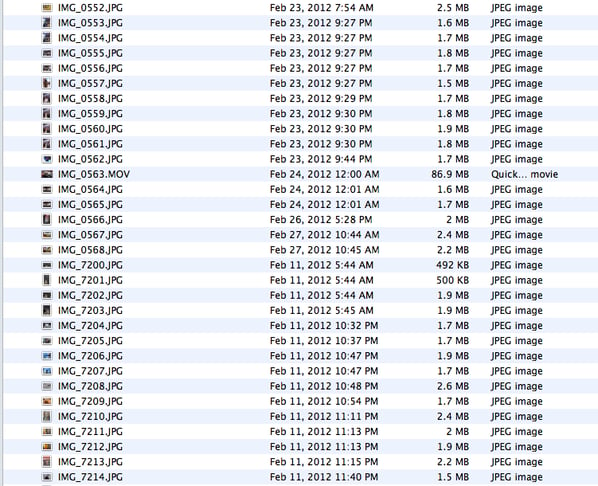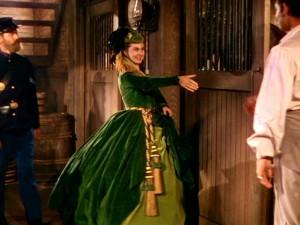Why Do We Allow Our Infrastructure To Decay?
30 October 2013
Not all history is recorded in writing or sound or images, but it exists in the world to be read and interpreted. This history of a city is written in its infrastructure and design, a mingling of the co-existant far ago and recent memory. Documentation such as photographs and oral histories and objects help relate that history when it has been erased from the landscape, but such mediums cannot capture the living history and emotional essence of epochal juxtapositions experienced in real time.
—–
I love train travel and visting new cities for the ability they provide to traverse areas outside the city center (at early hours before the city awakes) and read new histories. To see where industry happens or happened, where city services park their vehicles or where long haul truckers park overnight, where development is blossoming or where it occurred and has faded, where people live or where they used to live or where they would never ever ever live.
A city’s history is a story of planned and unplanned growth, of desires achieved and unrealized, of dreams and crushing reality.
A city’s history is written in the brick and steel and asphalt and paint of these fluctuations. Growth and decay. Growth and decay. Growth and decay. And, finally, decay.
—–
Decay, as with everything, is what infrastructure does. The urge to rebuild, of course, has its economic sources, but ultimately it is the impulse of social good. To revive an area, make it more livable or visitable, to improve public safety, to increase local pride, and to support the development of society and culture.
There may be economic impact from these things, such as jobs and tourism and real estate, but malls and industrial parks can bring that, too, without the positive impacts on health and community. We have the responsibility to invest in our infrastructure — outside of cities and in — for the good of society. This includes new development, maintenance, and rebuilding. The economic impacts we tend to focus on will follow, in ways we were unlikely to anticipate. But really, how does revenue compare to a child in Montana visiting a Smithsonian museum online, or the ability to walk safely outside and visit a nearby park, or bridges not collapsing on us?
—–
Archives are part of the infrastructure of history and culture. Like our physical infrastructure, they require continued maintenance and development to persist and remain viable. And as with our physical infrastructure, this work has massively overwhelming amounts of backlogs and incoming new work…and is massively underfunded and under appreciated.
But where this parallel is strongest is in the vital importance of each to the health and growth of our society. Underscoring this recently was the study — filed under “Well, duh.” — finding that reading literary fiction makes us more empathetic and increases our social perception and emotional intelligence. This improves our social interactions and ability to relate to and care about others, which ultimately supports the social good.
The material found in archives has the potential to expand on this by engaging the public with the history and thoughts of individuals, groups, and locations. Opening us to what has come before, thus helping us understand that something comes after us. Connecting us to stories and ideas that exist outside our own ideologies, our own little neighborhood, our own present concerns that fail to recognize the impact our decisions have on others and the impact that others can have on us.
—–
Archives are in a special position to do more than provide content for esoteric research or YouTube mashups. Archives have the opportunity to impact society in a positive way by providing insight and understanding, by keeping the memory and culture of a community alive for the benefit of that community and others, by showing us where we have succeeded and where we have failed in order to strive to be better.
As an archivist I feel we have a deep responsibility to serve in that way. That means there’s a lot of heavy lifting to be done to overcome the backlogs and challenges and crumbling infrastructure, work that needs to be done soon before we start losing too much of our past. It’s going to be hard, but it matters. It matters because history and culture make us care so we don’t recklessly destroy what we have built, and care so that we make what we have built better.
— Joshua Ranger
AVPreserve Releases Fixity And MDQC, Digital Preservation Tools
28 October 2013
AVPreserve is pleased to announce the release of Fixity and MDQC, two new digital preservation tools available for free download on our Tools page.
Fixity is a free open source utility for the documentation and regular review of stored files. Fixity scans a folder or directory, creating a manifest of the files including their file paths and their checksums, against which a regular comparative analysis can be run.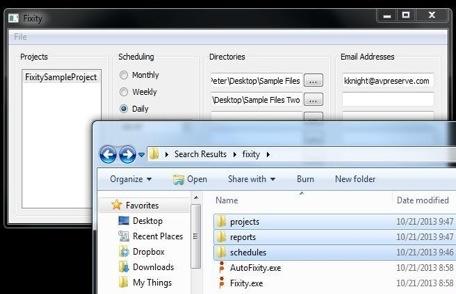 Fixity monitors file integrity through generation and validation of checksums, and file attendance through monitoring and reporting on new, missing, moved and renamed files.
Fixity monitors file integrity through generation and validation of checksums, and file attendance through monitoring and reporting on new, missing, moved and renamed files.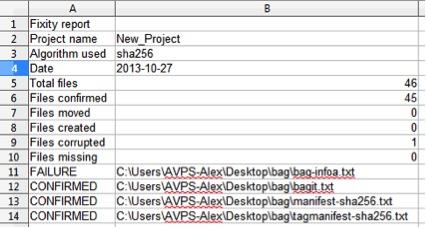 AVPreserve created Fixity after coming to the realization that:
AVPreserve created Fixity after coming to the realization that:
1. Checksum generation and validation are universally recognized as a primary mechanism for fulfilling the goal of fixity.
2. Generating checksums without systematically and routinely validating them is of little or no use.
3. Most organizations that “use checksums” only generate checksums but don’t validate them routinely, if at all.
4. The primary reason organizations don’t systematically and routinely verify checksums is because there is no tool that allows scheduling and reporting of validation.
5. Organizations that do routinely verify checksums do not typically monitor and report on file attendance types of information.
6. Overcoming the lack of resources and/or access to IT expertise is a critical factor in enabling organizations to fulfill the goal of fixity. Organizations need a simple, low cost tool.
There are many free and open source checksum utilities out on the market but they do not offer the feature set or simplicity necessary to fulfill the need that organizations have. Fixity was created with the sole focus of fulfilling the requirements of those concerned with monitoring fixity of a collection over the long term. It is intended for use in monitoring collections of files that are “final state”, or ready for deposit into an archive or preservation oriented repository.
MDQC stands for Metadata Quality Control. It is a free open source utility that reads the embedded metadata of a file or directory and compares it against a set of rules defined by the user.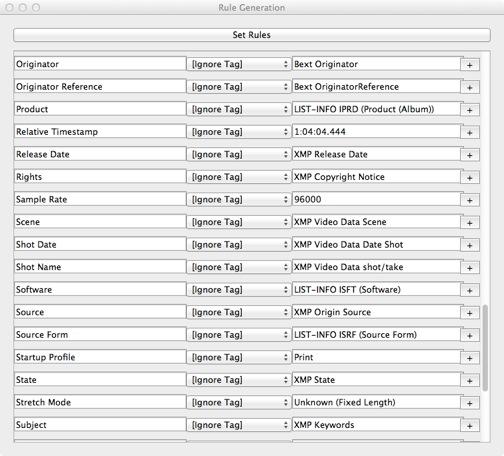 AVPreserve created MDQC after doing a great deal of wrangling data using a combination of scripts, ExifTool, MediaInfo, spreadsheets and formulas. The most common use to date has been to automate and minimize the time needed to QC large batches of digitized or reformatted assets. For instance, organizations have used MDQC on files being returned from a vendor or in-house lab to verify technical parameters, such as bit depth, sample rate, codec and aspect ratio, as well as non-technical parameters such as copyright statements, title information, identifiers and more.
AVPreserve created MDQC after doing a great deal of wrangling data using a combination of scripts, ExifTool, MediaInfo, spreadsheets and formulas. The most common use to date has been to automate and minimize the time needed to QC large batches of digitized or reformatted assets. For instance, organizations have used MDQC on files being returned from a vendor or in-house lab to verify technical parameters, such as bit depth, sample rate, codec and aspect ratio, as well as non-technical parameters such as copyright statements, title information, identifiers and more.
Although this has been the primary use so far MDQC can be used in any workflow where comparing actual metadata to expected metadata is useful. MDQC can be used on any file type supported by ExifTool and MediaInfo.
Direct downloads and User Guides of these (and other tools!) are available on our Tools page, or via the Fixity and MDQC GitHub pages.
Both of these applications are in beta. Please help refine them further by reporting all bugs to https://github.com/avpreserve/mdqc/issues or https://github.com/avpreserve/fixity/issues. User feedback is always welcome directed to info{@}avpreserve{dot}com.
9 Reasons You Understand More About Media Preservation Than You Think
28 October 2013
Plus 1 Bad Joke
Whether you are a trained archivist or not, you probably already understand some of the basic concepts of media preservation even if the technical scope if beyond you. You probably understand more than you allow yourself to think.
1. Metadata
Chances are you or someone you tolerate takes digital photos with a camera or phone, or has an iTunes library. Okay, or a Zune. In the case of the latter, I’m sorry. In the case of the former, do the photos downloaded to your computer look like this, making it impossible to find the photo you want:
And for the power nerds, er, power users out there, have you ever scoffed at how the MP3 of Neil Young’s Harvest and Harvest Moon has embedded the same album cover?! These are simple, apparent metadata points. Metadata is not data about data, but information about an object and how you can find it quickly in a messy file structure and how you can/should use it. Some of this information is highly technical or deeply buried, but you already understand how it helps you correctly identify and use content.
2. Obsolescence
VHS-C. ‘Nuff said.
3. Format Selection
Seinfeld, Season 7, Episode 16, “The Shower Head”
When selecting target format for digitization, there is a balance of quality, sustainability, what will perform the work you need it to perform, and what your organization and systems can reasonably handle. Don’t default to low-flow just because of resource savings and don’t be scared off from doing anything at all by the high-end ideal.
4. Presentation
Ever had the experience where you were looking at one of those digital photo frames and thought, “Boy, I’ve maybe let myself go a little of late, but I didn’t think I was ever that…wide. And I thought my head was fairly average-sized”? Most likely (not in my case because my head does need a massive pillow) those are older photos shot or printed at a smaller aspect ratio (3×5, 4×6) and automatically stretched to fit the 16×9 or similar wide frame. Applying the incorrect aspect ratio to digitized film and video can destroy the image (as well as your ego).
5. Duration
Chances are you listen to albums, watch TV, and/or watch movies.
Chances are you don’t like to waste things you’ve paid for.
If you don’t know the duration of some media content, if it’s a commercial work chances are its close to 30, 60 or 120 minutes, a newsclip may be in the 1-5 minute range, and field recordings or b-roll will fill as much of the tape as possible. These inferred durations will be close enough for planning digitization. Exact run times are not a priority in most catalogs. It can be figured out after digitization, by the digitized file.
6. Degradation
That Tupperware lid that doesn’t fit anymore after being microwaved or run through the dishwasher too many times. The plastic pen clip that snaps after you fidget with it too much in meetings. The patio furniture that discolors in the sun. Those cheap plastic bags at the pharmacy they have to double up (please just make them stronger and only give us one…) so they don’t sag and stretch.
Most physical media is made up of plastics and chemical goop. It decays accordingly.
7. Searchability
“Hey Phil, can you put the game on?”
“Sure thing — what channel?”
“I dunno, it’s somewhere in the 500s or 800s. Just flip through them.”
8. Reformatting
| Darned Socks | Conservation (Restoring the object as faithfully as possible to its original state.) | |
| Knee Patches | Restoration (Restoring the object close to its original state, albeit with certain non-original modifications in an attempt to enhance public consumption.) | |
| Cut-off Shorts | Access Copy (Lower resolution copy of an original that may reflect format or generational loss, or have certain editing decisions applied. Primarily for casual or near term use needs and may be considered disposable.) | |
| Quilt | Reuse (Repurposing or reformation of original content from one or multiple sources to create new content that does not necessarily reflect the essence of the original(s) but establishes its own qualities as a new object for care.) | |
| The Curtain Dress | Preservation (A newly created instance of the original at the highest quality possible with the most faithful reproduction of the original essence possible under reasonable, existing constraints. Is meant to be sufficient quality to replace the decaying original and move things ahead into the future.) |
9. Selection
I prefer Chubby Hubby to Cherry Garcia, so I will eat it first.
This pint of Chubby Hubby has been opened and this one is new. I will finish the open one first.
This pint will need hot fudge. The second pint is probably fine without it.
I can probably finish these two pints tonight, and then next week I can get two more. The Cherry Garcia can wait, or I can serve it to guests.
And 1.
Two archivists walk into a bar. One of them orders a bourbon on the rocks, the other an IPA. They begin to get into an intense discussion. The bartender says, “Hey, what do you guys do?” One of them says, “We’re archivists.” The bartender says, “Huh. What is that exactly?”
— Joshua Ranger
AVPreserve Releasing New Digital Preservation Tools To Celebrate World Day For Audiovisual Heritage
22 October 2013
To celebrate UNESCO World Day for Audiovisual Heritage, AVPreserve is releasing two new digital preservation utilities — Fixity and MDQC — and re-announcing the recent release of the tools Interstitial and AVCC. These utilities are designed to support various aspects of the digital preservation process, from selection and planning to quality control and monitoring. Each tool is free and open to the public. Visit https://www.avpreserve.com/avpsresources/tools/ on October 28th to download the source code and user guides.
Fixity: Fixity is a utility for the documentation and regular review and monitoring of checksums of stored files. Fixity scans a folder or directory, creating a database of the files, locations, and checksums contained within, against which a regular comparative analysis can be run.
MDQC: MDQC reads the embedded metadata of a file or directory and compares it against a set of rules defined by the user, verifying that the technical and administrative specs of the files are correct. This automates and minimizes the time needed to QC large batches of digitized assets, increasing the efficiency of managing digitization projects.
Interstitial: The Interstitial Error Utility compares two streams of the digitized audio captured on separate devices. Irregularities that appear in one stream and not in the other point to issues like Interstitial Errors that relate to samples lost when writing to disc. This greatly decreases the amount of time needed for QC of the integrity of digitized audio. Interstitial is available now.
AVCC: AVCC provides a simple template for documenting audio, video, and film collections, breaking the approach down into a granular record set with recommendations for minimal capture and more complex capture. The record set focuses on technical aspects of the audiovisual object with the understanding that materials in collections are often inaccessible and have limited descriptive annotations. The data entered then feeds into automated reports that support planning for preservation prioritization, storage, and reformatting. More information at https://www.avpreserve.com/news/avpreserve-metro-release-audiovisual-cataloging-reporting-tool/
Chris Lacinak Addressing Audio Engineering Society
17 October 2013
AVPreserve President Chris Lacinak will be speaking at this week’s Audio Engineering Society 135th International Convention in New York. Chris is part of the tutorial panel “National Recording Preservation Plan: Preservation Planning” along with David Ackerman (Harvard University), Matt Barton (Library of Congress), and Mark Hood (Indiana University).
Presented in association with the AES Technical Committee on Archiving Restoration and Digital Libraries, the tutorial is a direct response to recommendation 2.2 of the Library of Congress National Recording Preservation Plan stating the need to devise means to assist organizations in conducting comprehensive appraisals of audio collections with the goal of establishing priorities for preservation. The speakers will discuss tools and workflows their institutions have developed for preservation prioritization, and will provide demonstrations and discussion on the various approaches.
AVPreserve continues to develop free and open source tools for preservation planning and collection management (AVCC, Fixity, Interstitial, Cost of Inaction Calculator, and more) that will be a part of the discussion, and we are honored to be involved in helping other institutions such as Indiana University and the Federal Agencies Digitization Guidelines Initiative develop their own tools. We’re excited to be a part of this panel. Hit Chris up at AES if you’re attending or look for the AVPreserve crew at one of the many conferences we attend for more information on these efforts.
Things We Learned At The New York Archivists Round Table Awards Ceremony
11 October 2013
*The awards ceremony was started in 1989 to mark the 10th anniversary of NYART. The first award for Innovative Use of Archives was given for a project based in Brooklyn, because at that point in time doing anything in Brooklyn was an innovation.
*The New York Archives Conference originally began as the Lake Ontario Archives Conference with attendees primarily from western New York and Canada. We finally got rid of the Canadians in 1999.
*The only thing you really need to learn to pass kindergarten: Correct identification of farm animals.
*The secret location of the NYART archives. This information is for NYART members only, but did you know that anyone can become a member, either as a professional or a Friend of ART?
*Wang computers.
*If you think the technology of creating digital artworks is hard, think about the technology needed to preserve them.
*NYART awards directly impact the support of archives (i.e., looks good in funding applications).
*Nat King Cole’s wax hands.
*Archivists are humble about and quick to acknowledge the importance of collaboration and the support of colleagues.
*teacharchives.org
*These people are awesome:
Peter Wosh, Director, Archives and Public History Program, NYU – Award for Archival Achievement
New York Archives Conference (Geoffrey P. Williams, University Archivist, SUNY University at Albany accepting) – Award for Outstanding Support of Archives
Rhizome Artbase (Heather Corcoran & Ben Fino-Radin accepting) – Award for Innovative Use of Archives
Brooklyn Historical Society Students and Faculty in the Archives Project (Julie Golia, Public Historian and Robin M. Katz, Outreach & Public Services Archivist accepting) – Award for Educational Use of Archives
Check out the program from the ceremony here. Congratulations to all of the winners! And thanks to all the great presenters and NYART Board for a fun evening!
METRO AND AVPRESERVE LAUNCH PODCAST SERIES ABOUT ARCHIVES AND SPECIAL COLLECTIONS
9 October 2013
METRO and AVPreserve announce the launch of More Podcast, Less Process, a new podcast series featuring in-depth and wide ranging interviews with archivists, librarians, preservationists, technologists, and information professionals about interesting work and projects within and involving archives, special collections, and cultural heritage.
With Co-Hosts Jefferson Bailey of METRO and Josh Ranger of AVPreserve, guests will discuss their individual work and its relation to the broader archival enterprise. Topics will cover professional issues that impact archivists and special collections librarians today, including appraisal and acquisition, arrangement and description, outreach and education, collection management, physical and digital preservation, and infrastructure and technology.
Kicking off the series is CSI Special Collections: Digital Forensics and Archives featuring digital archivists Mark Matienzo of Yale University and Donald Mennerich of New York Public Library discussing digital forensics and other matters involved with acquiring and managing digital collections. Episode 1 is now available through iTunes, Internet Archive, and as a direct download via the podcast series’s website.
More Podcast, Less Process is part of METRO’s Keeping Collections programming. Keeping Collections was launched to ensure the sustainability and accessibility of New York State’s archival collections as part of the New York State Archives Documentary Heritage Program. Keeping Collections provides a variety of free and affordable services to any not-for-profit organization in the metropolitan New York area that collects, maintains, and provides access to archival materials.
More Podcast, Less Process is licensed under the Creative Commons Attribution-NonCommercial-ShareAlike 3.0 Unported License and is available via your regular media dissemination channels.
AVPreserve Participating At AMIA, MARAC Conferences
9 October 2013
AVPreserve is excited to be participating in the upcoming Association of Moving Image Archivists Annual Conference (November 6th-9th, Richmond, Virginia) and Mid-Atlantic Regional Archives Conference (November 7th-9th, Philadelphia, Pennsylvania) in a number of ways.
* After beginning his term as a newly elected AMIA Board Member, AVPreserve Founder and President Chris Laciank will present about the Cost of Inaction (CoI) tool we have been developing on the panel Magnetic Media Stream: The End of Analog Media: The Cost of Inaction and What You Can Do About It along with fellow panelists Mike Casey (Indiana University) and Marius Snyder (PrestoCentre). The CoI tool produces reporting that show the negative cost impact — based on money already spent and the cost of losing decaying/obsolete assets — of not doing preservation reformatting in the near term.
* Senior Consultant Kara Van Malssen has helped arrange the first ever AMIA / Digital Library Federation HackDay — a full-day event bringing together audiovisual archivists with software and web developers for an intensive day of creativity and problem solving — and then will be on the panel From Zero to DAM! with Miwa Yokoyama (Carnegie Hall) and Eva Radding (Facing History and Ourselves) discussing their efforts to select and implement DAM solutions for digital video assets.
* Consultant Seth Anderson will be on the panel Navigating the Digital Archive: First, Know Thyself discussing the process of developing business cases around digital preservation needs, and then will present the stand alone paper Mastering Your Data: Tools for Metadata Management in AV Archives.
* Inventory Assistant Shira Peltzman will be discussing the preservation challenges of digital cinema packages in her talk Everything You Always Wanted to Know About DCPs (But Were Afraid to Ask) that follows up on her recently completed thesis work at NYU.
* At MARAC, Consultant Alex Duryee will be on the panel Refining Archival Data speaking about using Open Refine to clean up and normalize large data sets, and Consultant Kathryn Gronsbell will be on the panel Archiving, Preservation and Access of Complex Artworks with clients from MOMA, Cornell, and Eyebeam to help discuss their various preservation projects focused on complex media artworks.
Also be sure to keep an eye out for the AVPreserve crew to find out more about our AMIA House Party and MARAC Bar Night. Looking forward to seeing everyone!
AVPreserve President Chris Lacinak Elected To AMIA Board
8 October 2013
Congratulations to AVPreserve Founder and President Chris Lacinak upon his election to the Association of Moving Image Archivists (AMIA) Board of Directors. The Board meets regularly to help “ensure that AMIA’s mission is fulfilled and to provide strategic leadership to move the association forward”. Chris is a long-time member of AMIA, regularly presenting at the Annual Conference and contributing to various committees, as well as the audiovisual preservation knowledge base overall. His two-year term will begin at next month’s conference in Richmond, VA, where he looks forward to being even more involved as a participant in directing the continuing development of the field and the resources needed to do our work. Congrats as well to Tom Regal (Director of the Board), Jacqueline Stewart (Director of the Board), and Caroline Frick (President of the Board) on their selections as well.
AVPreserve Collaborates On First AMIA Hack Day
2 October 2013
The 2013 Association of Moving Image Archivists Annual Meeting will feature the first ever Digital Library Federation/AMIA Hack Day to take place on November 6th in Richmond, Virginia. Along with co-conspirators Lauren Sorensen (Bay Area Video Coalition) and Steven Villereal (University of Virginia), AVPreserve Senior Consultant Kara Van Malssen is helping to organize the event.
Hack Days are designed to provide a collaborative workspace where people with different skill sets can come together to develop technological solutions to specific problems in a condensed amount of time. The AMIA event will be a unique opportunity for practitioners and managers of digital audiovisual collections to join with developers and engineers for an intense day of collaboration to develop practical solutions around digital audiovisual preservation and access.
To be successful these events require the input of people who care for collections in addition to people with strong technical and programming skills. There is a lot of room to explore and create in the area of digital video preservation, so we hope you’ll come help! The event is free, and further information can be found on the AMIA / DLF Hack day Registration Form. See you in Richmond!
